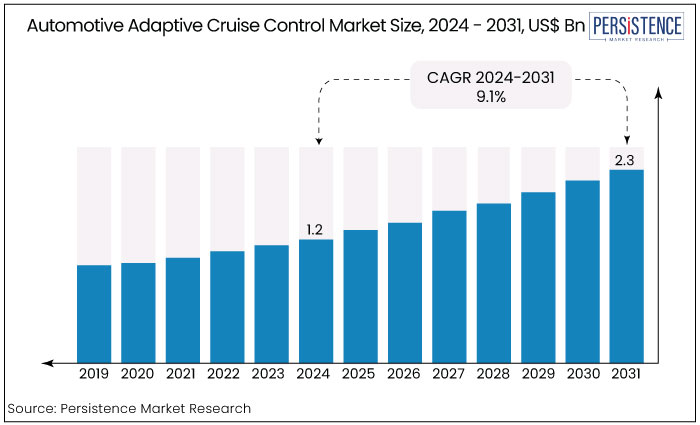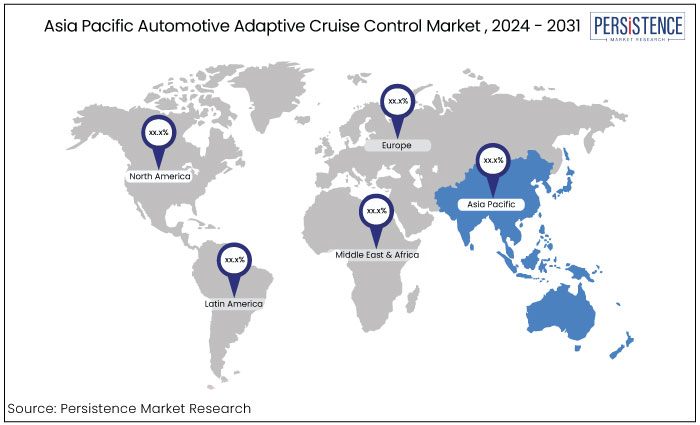Industry: Automotive & Transportation
Published Date: October-2024
Format: PPT*, PDF, EXCEL
Delivery Timelines: Contact Sales
Number of Pages: 188
Report ID: PMRREP34862
The automotive adaptive cruise control market is estimated to increase from US$1.2 Bn in 2024 to US$2.3 Bn by 2031. The market is projected to record a CAGR of 9.1% during the forecast period from 2024 to 2031. The market growth is attributed to the increasing focus on road safety, growing demand for ADAS, and the expansion of electric and autonomous vehicles. The market is expected to continue growing as the automotive industry shifts toward electrification and automation.

Key Highlights of the Market
|
Market Attributes |
Key Insights |
|
Automotive Adaptive Cruise Control Market Size (2024E) |
US$1.2 Bn |
|
Projected Market Value (2031F) |
US$2.3 Bn |
|
Global Market Growth Rate (CAGR 2024 to 2031) |
9.1% |
|
Historical Market Growth Rate (CAGR 2019 to 2023) |
8.3% |
Asia Pacific region is projected to emerge as lucrative market. Regional market growth is fueled by the region's access to low-cost raw materials and the mass production capabilities of adaptive cruise control technologies. Significant advancements in automotive tech particularly in sensors, radar systems, and artificial intelligence further bolster market expansion.
Collaborations between automakers and tech firms are pivotal in enhancing adaptive cruise control systems. For instance, BlackBerry Ltd. formed a partnership with StradVision in 2020, leveraging StradVision's AI camera recognition technology with QNX software for advanced driver assistance systems and autonomous vehicles produced by Korean manufacturers.
Rising consumer disposable incomes are shifting preferences from entry-level to mid-range vehicles intensifying demand for ACC sensors in the region.

Europe market is poised for steady growth driven by supportive initiatives like EuroNCAP, which streamline the integration of safety features into vehicles. Notably, the German automotive sector is a leader in this arena investing nearly one-third of its annual revenue into research and development focused on enhancing safety technologies.
Germany's advanced infrastructure further positions it to dominate the market share for a 7.25% during the forecast period. Additionally, the presence of prominent regional manufacturers and a rising consumer awareness concerning vehicle safety are pivotal factors propelling market growth. As safety becomes a top priority for consumers, the demand for sophisticated adaptive cruise control systems is expected to increase significantly across Europe.
The automotive adaptive cruise control market is categorized based on component into three segments such as LiDAR, RADAR, and camera technologies. Among these, LiDAR is projected to emerge as the leading segment throughout the forecast period. The increasing trend toward highly safe and efficient self-driving vehicles significantly drives the demand for LiDAR technology.
Utilizing laser-based technology, LiDAR accurately measures the distance between the vehicle and surrounding obstacles relaying signals to the adaptive cruise control system to adjust the vehicle's speed accordingly. The growing adoption of ACC systems in passenger cars bolsters LiDAR's dominance, while its rising implementation in commercial vehicles also contributes to steady growth in this segment ensuring its relevance in the evolving automotive landscape.
The automotive adaptive cruise control market is segmented by vehicle type into passenger cars and commercial vehicles, with the passenger car segment expected to lead throughout the forecast period. This growth is largely driven by stringent government regulations mandating the inclusion of driver assistance systems that enhance vehicle safety.
The rising global production of passenger vehicles plays a crucial role in sustaining the dominance of the segment. Automakers are making substantial investments in research and development resulting in continuous technological advancements. These innovations are making adaptive cruise control systems increasingly cost-effective and user-friendly, facilitating their integration across a broader range of vehicle models. As a result, the passenger car segment is set to thrive in the evolving automotive landscape.
Automotive adaptive cruise control (ACC) is an advanced driver-assistance system that automatically adjusts a vehicle's speed to maintain a safe distance from the vehicle ahead.
Working through sensors like radar and cameras, ACC detects the speed and distance of surrounding vehicles enabling it to accelerate or decelerate as necessary. This technology enhances driving comfort and safety by significantly reducing the need for constant speed adjustments during highway travel.
ACC is widely used in modern vehicles contributing to the growing trend of automation in the automotive industry, and serves as a foundation for advanced systems such as autonomous driving. The sector is experiencing significant growth driven by increasing consumer demand for enhanced safety features and the push for automated driving technologies.
Key automotive adaptive cruise control market trends include the integration of artificial intelligence and machine learning algorithms to improve ACC responsiveness and accuracy. The growing popularity of electric vehicles is boosting innovations in ACC systems further.
Collaborations between automotive companies and tech firms are also on the rise with the aim of developing sophisticated systems that can communicate with other vehicles and infrastructure.
The automotive adaptive cruise control market has witnessed significant growth over the past few years with a CAGR of 8.3% during the period from 2019 to 2023. This growth can be attributed to the increasing emphasis on safety features and the rising adoption of advanced driver-assistance systems (ADAS) within the automotive sector.
As consumers become more aware of the benefits of technologies that enhance driving comfort and safety, manufacturers have prioritized the integration of ACC systems into new vehicle models contributing to this upward trend.
The ACC market is projected to accelerate even further with a forecasted CAGR of 9.1% during the period from 2024 to 2031. This anticipated growth reflects a broad shift toward automation and smart mobility solutions.
As innovations in artificial intelligence and sensor technologies continue to evolve, ACC systems are expected to become sophisticated and reliable. Furthermore, the increasing adoption of electric vehicles and the development of autonomous driving technologies will likely to open several market opportunities.
Increasing Focus on Road Safety
One of the primary drivers for the automotive adaptive cruise control market expansion is the heightened emphasis on road safety. Governments and regulatory bodies worldwide are implementing stringent safety standards and guidelines for vehicles, which push manufacturers to include advanced safety features like ACC.
By automatically adjusting a vehicle's speed to maintain a safe distance from other vehicles, ACC reduces the risk of rear-end collisions and enhances driving safety. As consumer awareness of road safety increases, drivers are more inclined to choose vehicles equipped with ACC, further propelling market growth.
Initiatives aimed at reducing traffic accidents and fatalities are encouraging manufacturers to invest in this technology making it a critical factor for future vehicle development.
Growing Demand for ADAS Remains a Significant Driver
The rising demand for Advanced Driver-Assistance Systems (ADAS) is another significant driver propelling automotive adaptive cruise control market demand. As technological advancements continuously enhance the automotive landscape, consumers increasingly seek vehicles that offer improved convenience and safety features.
As a key component of ADAS, ACC plays a vital role in providing drivers with relaxed driving experience by automatically managing speed and distance. This demand is further driven by the integration of ACC with other systems such as lane-keeping assist and automatic emergency braking creating a comprehensive suite of safety solutions. Automotive manufacturers are responding to this trend by incorporating ACC into their offerings, thus driving the market growth and appealing to tech-savvy consumers.
Expansion of Electric and Autonomous Vehicles
The expansion of electric and autonomous vehicles is a crucial driver for the automotive adaptive cruise control market growth. ACC systems are becoming increasingly important as the automotive industry shifts toward electrification and automation.
Electric vehicles (EVs) often come equipped with cutting-edge technologies including ACC to enhance energy efficiency and driving range by optimizing speed management. Furthermore, as manufacturers develop autonomous vehicles, ACC serves as a foundational technology that supports high levels of automation.
The integration of sophisticated sensors and communication systems in these vehicles allows for accurate and responsive adaptive cruise control functionality. As the market for EVs and autonomous vehicles continues to grow, the demand for advanced ACC systems is expected to rise further accelerating market expansion.
Consumer Reluctance and Trust Issues
Another factor hindering the automotive adaptive cruise control market is consumer reluctance and trust issues regarding automated driving technologies. Many drivers remain skeptical about the reliability and safety of ACC systems fearing potential malfunctions or over-reliance on technology. This skepticism can lead to hesitance in purchasing vehicles equipped with ACC, as consumers may prefer traditional driving methods.
Negative media coverage surrounding autonomous technologies can exacerbate these concerns making it essential for manufacturers to invest in consumer education and demonstrate the safety and effectiveness of ACC systems.
High Costs of Implementation
One significant factor impeding the growth of automotive adaptive cruise control sales is the high costs associated with the development and implementation of these advanced systems. Integrating ACC requires sophisticated sensors, software, and hardware, which can significantly increase the overall vehicle price. This can deter budget-conscious consumers from opting for vehicles equipped with ACC, limiting market penetration.
Manufacturers may face challenges in balancing the cost of incorporating ACC with maintaining competitive pricing, which can slow down the adoption of this technology in the broad automotive market.
Integration of Vehicle-to-Everything (V2X) Communication Technology
One promising future opportunity for the automotive adaptive cruise control market lies in the integration of Vehicle-to-Everything (V2X) communication technology. This technology enables vehicles to communicate with other vehicles, infrastructure, and even pedestrians, creating a more cohesive traffic ecosystem.
Incorporating V2X capabilities in ACC systems can receive real-time data on traffic conditions, road hazards, and even upcoming traffic signals. This allows for more accurate speed adjustments and safe driving experiences. This integration can enhance the performance of ACC making it responsive to dynamic driving environments.
As smart city initiatives and connected vehicle technologies continue to grow, the demand for advanced ACC systems is expected to grow. This demand presents a significant opportunity for manufacturers.
Government Incentives and Innovative Strategies Implemented
Numerous governments worldwide have implemented innovative strategies to address the alarming increase in road accidents. To enhance vehicle safety, they are enforcing stringent regulations on automakers demanding improvements in safety technologies, including automotive adaptive cruise control systems.
Various transportation associations and trade unions have also established safety guidelines that necessitate the integration of ACC in vehicles to protect drivers and passengers alike. In response to these demands, leading manufacturers are committing substantial resources to research and development efforts. They are focusing on creating advanced long-range radar systems that work in conjunction with ACC enabling vehicles to automatically adjust their speed based on real-time traffic conditions, thus significantly enhancing overall road safety.
The automotive adaptive cruise control market is highly competitive, with leading global automotive manufacturers vying for a larger market share. Key players in the industry include Bosch, Continental, Denso, Magna, and Aptiv, among others. These companies are continuously investing in research and development to introduce innovative ACC solutions that cater to evolving consumer preferences and regulatory requirements.
In 2022, Bosch unveiled its latest generation of ACC systems incorporating advanced radar and camera sensors as well as machine learning algorithms to enhance accuracy and responsiveness. These technological advancements are driving the competitive landscape and shaping the future of the market.
Recent Developments in the Automotive Adaptive Cruise Control Market
|
Attributes |
Details |
|
Forecast Period |
2024 to 2031 |
|
Historical Data Available for |
2019 to 2023 |
|
Market Analysis |
US$ Million for Value |
|
Key Regions Covered |
|
|
Key Market Segments Covered |
|
|
Key Companies Profiled |
|
|
Report Coverage |
|
|
Customization & Pricing |
Available upon request |
By Component Type
By Vehicle Type
By Region
To know more about delivery timeline for this report Contact Sales

The market is predicted to rise from US$1.2 Bn in 2024 to US$ 2.3 Bn by 2031.
A few leading industry players in the market are Robert Bosch GmbH, Continental AG, ZF Friedrichafen AG, and Mando Corporation.
The passenger car segment is expected to lead the market due to stringent government regulations that enhance vehicle safety.
Asia Pacific region to dominate the market due to access to low-cost raw materials and mass production capabilities.
A key opportunity lies in the integration of ACC with other systems.